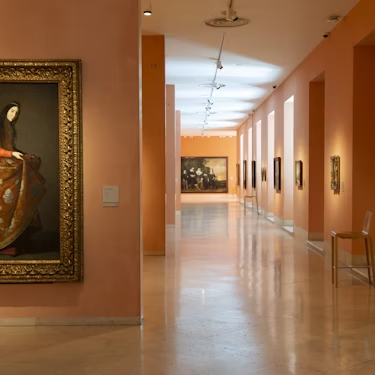More about: 10 Things to Do in Madrid in the winter
Although it has a reputation for being a city where the cold takes over in the winter months, everything there is to see and do in Madrid is usually joined by a large number of events and activities during that season. For that reason, you should not hesitate to come to know it in that season.
In fact, you have dozens of reasons to travel to the capital between November and March, from the traditional Three Kings Parade to the Chinese New Year. Read on and find out what to do in winter.
1. Go shopping at Christmas markets
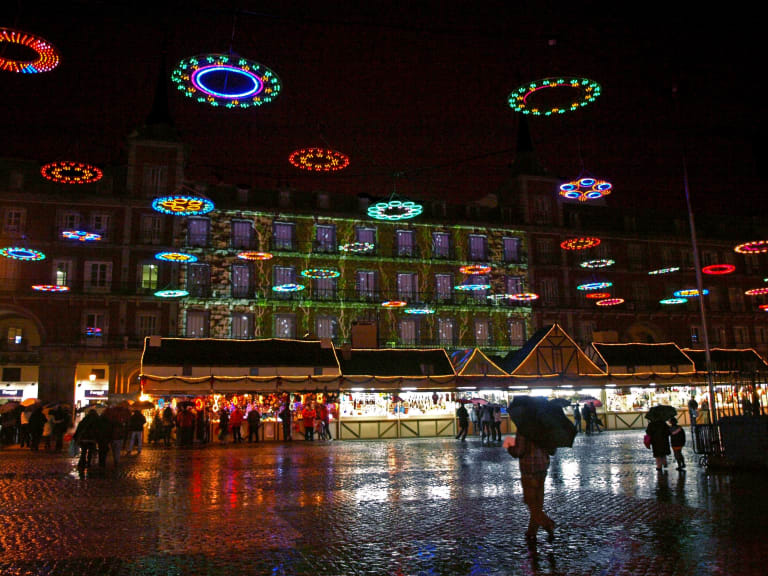
In the winter season, Madrid is full of booths and stalls. The most famous Christmas market takes place at the end of November in the Plaza Mayor. This central location has welcomed merchants and customers since the early 17th century, when the architect Juan Gómez de Mora finished remodeling the esplanade.
If in its origins you could buy meat, vegetables and live animals (especially turkeys), today it is the privileged destination to buy Christmas decorations, nativity scenes and joke articles. Alternatively, you can opt for the markets that are installed in other parts of the capital. Among the most outstanding, we can mention:
- Feria Mercado de Artesanía de la Comunidad de Madrid (Paseo de Recoletos).
- Mercadillo del Gato (an ephemeral event held at The Westin Palace Hotel, Plaza de las Cortes 7).
- Las lonjas (fish markets) set up in Madrid Río Park (Paseo de la Chopera 10).
- Craft market in Plaza Isabel II
Save at the outlet at Las Rozas Village
If you like luxury brands but want to save money there is an outlet on the outskirts of Madrid that you will love. It is in the municipality of Las Rozas and is such a tourist interest that raises among travelers more 'trendy' that excursions are organized from the capital to go to the outlet shopping. Las Rozas Village has many fashion and jewelry boutiques such as Carolina Herrera, Karl Lagerfeld or Swaroski. And all at very good prices.
2. Take refuge at the Prado Museum
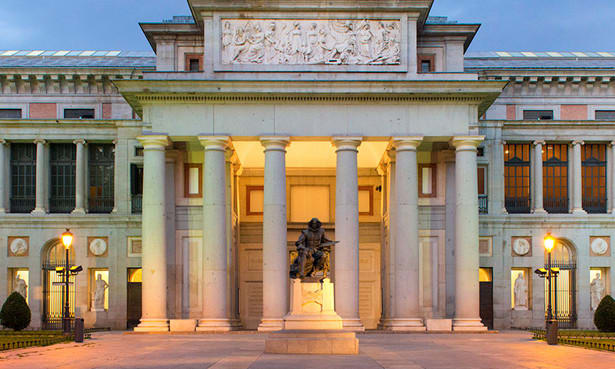
If rain or bad weather do not allow you to do outdoor activities, you can always visit the Prado Museum, the most important art gallery in the country.
The building that houses the museum was built during the reign of Charles III, although in the intentions of the monarch was to house the Cabinet of Natural Sciences. However, his grandson Ferdinand VII and Queen Maria Isabel de Braganza decided to turn it into a space to exhibit the best paintings and sculptures of the country.
Today, the museum has the most important collection of Spanish paintings in the world. As you can see in this article about the best paintings of the Prado, its rooms host works of classic authors such as Goya ("The 3rd of May in Madrid", "The Naked Maja", "Saturn", etc.), Velázquez ("Las Meninas", "Adoration of the Magi", etc.) and El Greco ("The Knight with his hand on his chest", "The Trinity", etc.).
3. Board the Philip II Train to go to El Escorial

Although winter officially ends on March 21, this month is generally characterized by warmer temperatures. At this time of year, the Tren de Felipe II once again runs between Príncipe Pío station and El Escorial. If you want to see all that the monastery of El Escorial has to offer, this is one of the most special ways to get to the monument from Madrid.
It consists of four cars from the forties pulled by a diesel locomotive. After leaving behind the Madrid station, the convoy enters the Sierra de Guadarrama, a natural environment a few kilometers from the capital.
In just under an hour you will reach this peaceful mountain town. The train ticket includes a visit to the most famous monument of this town: the Monastery of El Escorial, a group of buildings that includes a royal palace, a monastery, a basilica, a pantheon and a library.
Those who are passionate about means of transport have one more reason to come here: a few meters from the Monastery are the King's Coach Houses, a collection of horse-drawn carriages, sleighs and other objects.
4. Visit a city with a lot of charm: Segovia

If you stay in Madrid for four days, you can dedicate a day to visit Segovia. With a little luck, you will see its famous castle covered by a white cloak. The fortress stands on a rock spur overlooking the valley and its slate-roofed towers remind us of Cinderella's castle.
The other icon is the spectacular Roman aqueduct that transported water from the Sierra de Guadarrama. Splendidly preserved, it is the first monument you will find when you arrive as it marks the beginning of the old town.
Another must-see attraction is the Cathedral, which blends three architectural styles: Romanesque, Gothic and Renaissance.
Declared a UNESCO World Heritage Site, this city is perfect for a romantic getaway. From Madrid, you can get here by train from Chamartín station. However, if you are short on time, I recommend you to book an organized excursion to Segovia.
5. Celebrate the Chinese New Year

In the capital, the Chinese community resides mostly in Usera, a neighborhood that borders Madrid Rio Park. In the nineties, citizens of the Asian country moved here and, little by little, the traditional establishments have been replaced by restaurants, bazaars, hairdressers and other stores aimed at the Oriental public.
Madrid's Chinatown is concentrated around the streets Nicolás Sánchez, Dolores Barranco, Olvido and Marcelo Usera. From the center, you can get here by metro (from Sol, yellow line to Legazpi + circular line to Usera).
The Chinese New Year is celebrated between January and February; the date changes every year but there is one thing that always remains the same: the colorful parties that animate the streets of Usera.
Between January and February, the neighborhood is filled with parades, floating lanterns, dragons, fireworks and much more. You can check the full program on the official website of the City of Madrid. After a stroll, you can take advantage of the occasion to experience something typical:
- The Alley, for bubble tea lovers. If you do not know it, it is tea mixed with fruit, fruit syrup, yogurt or milk and tapioca pearls (Plaza Julián Marías, Local 4).
- Hong Kong 70 in Chinatown, the restaurant famous for its lacquered duck. As tradition dictates, diners can watch how the chefs choose and prepare each recipe (Calle Nicolás Sánchez 11). Another option (also for take-out) is the Tong-Fu Duck Rotisserie (Calle Nicolás Usera 71).
- Wenzhou Supermarket, where you can buy unique goods: Nori seaweed, crunchy dates, bamboo mushrooms, tofu skewers and much more. For more info, you can check their website (Calle de Dolores Barranco 70).
- Buddhist Temple, a place of worship dedicated to Tibetan Tantric Buddhism (Calle Luis de la Torre 12).
6. Admire the almond trees in bloom
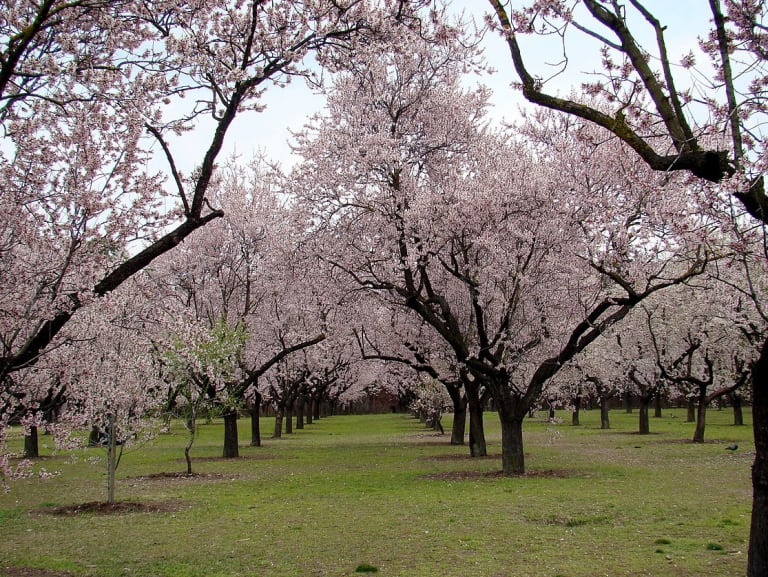
Between late February and early March, the capital's almond trees are filled with pink blossoms. The Japanese call it "hanami" and it is one of the most awaited events in Japan. The tradition has crossed the borders of the rising sun and this spectacle of nature attracts an increasing number of admirers.
Possibly, there are no three better parks where you can see it during your stay in Madrid than the following:
- La Quinta de los Molinos, 21 hectares of almond, olive and eucalyptus trees. It is a bit far from the center - the nearest stop is Suanzes, green line towards Alameda de Osuna - but I assure you that it is worth taking the metro. It was owned by the Count of Torre Arias who gave it to the city council in 1920. Even so, it remains unknown to many Madrileños although its popularity grows from year to year (Calle Alcalá 527).
- Botanical Garden, the trees are located behind the Villanueva Pavilion. If you want to keep up to date, I recommend checking their Instagram profile from time to time (Plaza Murillo 2).
- Huerta de la partida, an area of 38,000 square meters on the banks of the Manzanares. In what was once the orchard of the Vargas family, almond, fig, hazel and other trees were planted. You will recognize the place by the waterless riverbed that recreates the Meaques stream (Madrid Río Park, halfway between the Casa de Campo pond and the King's Bridge).
7. Enjoy a hot chocolate

Although you may not know it, Madrid and chocolate are closely linked. The first cocoa beans arrived in the capital in 1520 and the first to consume them were the monks. They used to drink a few hot cups during fasting as it was not considered a food.
Later, it became the favorite drink of aristocrats who used it in the feast, a snack offered to their guests. During the ritual, chocolate was served along with sponge cakes, buns, sweetened bread and a glass of ice cream called "búcaro de nieve".
In Madrid, the Chocolatería San Ginés is a true institution. It has been serving churros and hot chocolate since 1894 and its tables have seated such celebrities as Valle-Inclán, Maradona and U.S. President Jimmy Carter. It is located in the Pasadizo de San Ginés, a stone's throw from the more famous Calle Arenal.
Other options are La Antigua Churrería ( Calle Bravo Murillo 190 and Calle Conde de Peñalver 32), Chocolat (Calle Santa María 30) and Churrería Los Artesanos 1902 (Calle de San Martín 2).
8. Skiing in Xanadu

To practice snowboarding inside a shopping mall, there is no need to fly to Dubai. A few kilometers from the capital is Xanadú Snowzone, the only indoor snow slope in our country.
The indoor space is designed for everyone, you don't need to be an expert skier! In fact, it has a practice area (initiation slope) and an area dedicated to children (Telebaby). For more information, I recommend you check the official website.
9. Glide on ice
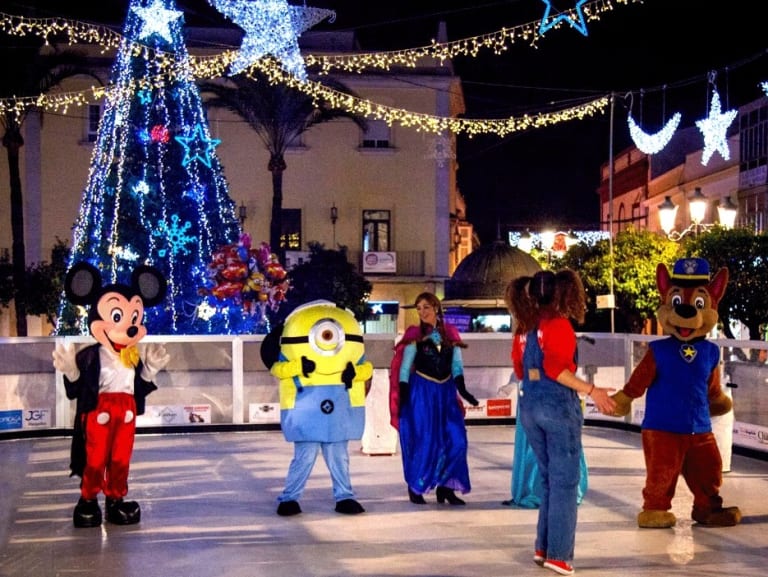
What winter would be without ice rinks? In the capital, the most similar situation to Rockefeller Center in New York is in Plaza de España.
After its renovation, this space in Madrid has been reborn and the new pedestrian walkway connects it with the Royal Palace and the Temple of Debod. Here you can skate on a large surface at the foot of the Hotel Riu.
However, it is not the only one in the city. Other destinations are Plaza Colón, Matadero (Plaza Legazpi 8), Palacio de Hielo ( a large complex in Arturo Soria, Calle de Silvano 77), Galería de Cristal del Palacio de Cibeles (Calle Montalbán 1) or the rink in Plaza Juan Goytisolo, near the Reina Sofía Museum and Atocha station.
10. Treat yourself to a sweet treat

The Roscón de Reyes is the symbol of Christmas. The capital has many establishments that follow the traditional recipe or elaborate new varieties. Discover the best places!
- Pan.Delirio, an establishment run by Javier Cocheteux father and son. The workshop uses sourdough and stone-ground organic flour. Their desserts hide the traditional elements: a porcelain figure and a bean (Calle Juan Bravo 21, Calle Profesor Waksman 8 and Calle Naranjo 7).
- Mallorca, a classic in Madrid. Acolytes come every year to take home a roscón that is soft on the inside and crunchy on the outside. It has several stores, for more info I recommend you take a look at their official website.
- Panem, the best roscón de Reyes in Madrid 2022. The jury has awarded it by unanimous decision after a blind tasting. It is located in the neighborhood of Ibiza, near the Retiro Park (Calle Fernán González 42).
- Moulin Chocolat, a signature roscón. Its creator is Ricardo Vélez, the "cocoa chef". You can choose between four options: without filling, with cream, with toasted yolk or with truffle (Calle Alcalá 77).
- Panod, Pastry chef Andrés Alvite has worked with Oriol Balaguer, a national pastry reference. Since 2017, his roscones have conquered the top positions in gastronomic rankings. You will find it in the heart of Chueca (Calle Prim 1).
What to pack in your suitcase to visit Madrid in winter?

In the capital, winters are not very cold and are characterized by low humidity. Despite its high altitude, snow is not very common and the most rigid month is January. Already in the middle of February, temperatures start to rise. Therefore, a sweater, a heavier sweater and a hooded sweatshirt cannot be missing in your suitcase.
As for rain, November and December concentrate the highest percentage of precipitation. If you plan to make an excursion to the Escorial Monastery or other locations in the mountains, take a scarf and a winter hat with you.




